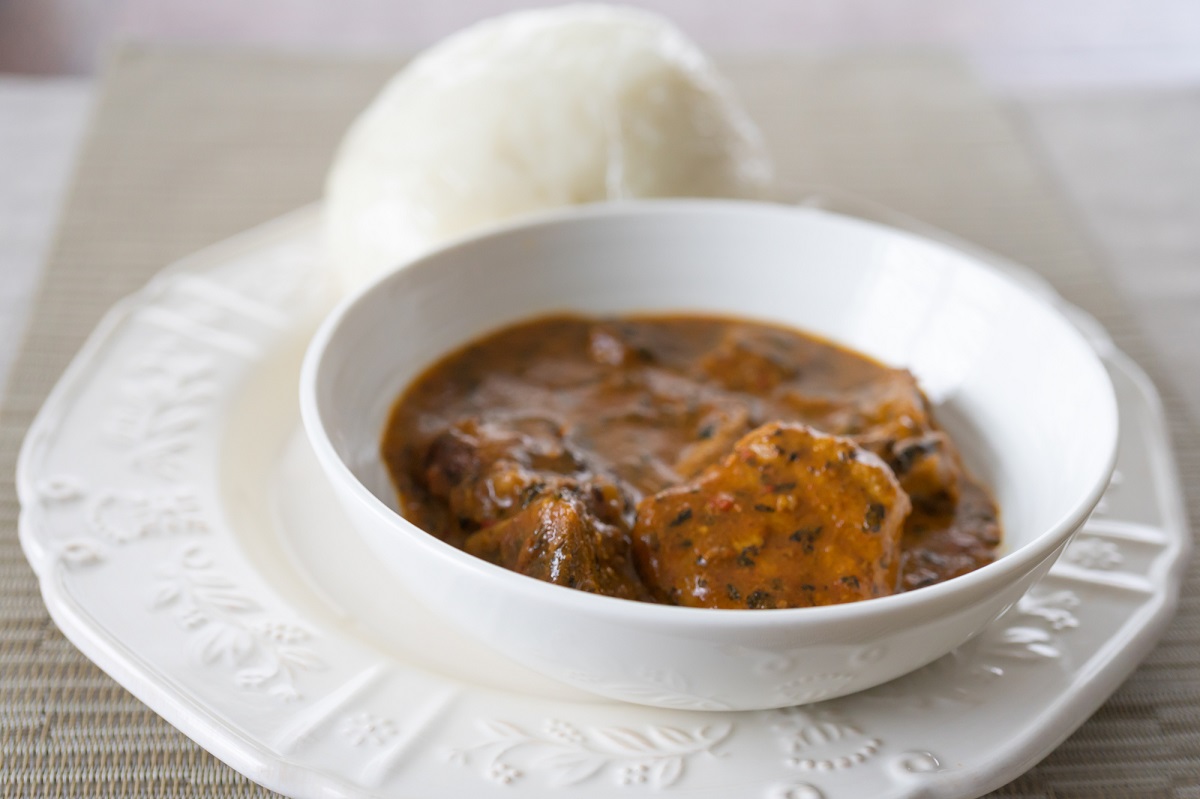If you have leftover fufu, there are several options about how to reheat fufu, depending on your preference. However, it is important to be cautious when using a microwave as it can lead to burnt, dry or mushy pieces of dough if overheated. To prevent this, consider the following options for reheating fufu.

What Is Fufu
Fufu is a staple food found in many countries in Central and West Africa and some Caribbean countries, such as the Dominican Republic.
It is traditionally made by thoroughly mixing and pounding equal parts of cassava and green plantains with water, but it can also be made by boiling the cassava and plantains and blending them in a food processor or blender before shaping them into little balls. Fufu is often eaten with African soups such as okra soup or ogbono soup, and it’s also known as foo-foo, fou-fou, and foufou, and it’s known as cous-cous in French-speaking areas.
The word “fufu” originates in the Twi language of Ghana and the Ivory Coast and is of West African origin. It means “to mash” or “to combine”, and was brought to the Americas by enslaved populations and adapted into Caribbean cuisines according to the available ingredients. The East and Southern African equivalent is Ugali.
This African dish can be enjoyed with a variety of African soups including: light, vegetable, and spicy soups with ingredients such as chicken, beef, lamb, goat, or fish. Some of the most delicious African soups that pair well with this popular dish are Okro (Okra) Soup, Ewedu Soup, Ogbono Soup, Banga Soup, and Egusi Soup.
What Is Fufu Made Of
Fufu is a traditional African dish made using starchy vegetables native to the region. It can be made from a variety of ingredients including cassava, yams, maize, plantain, wheat, corn, semolina, rice, sweet potatoes, or oatmeal. The process of making fufu is a simple but physical task that involves pounding and molding the ingredients into a large, dough-like shape.
It is traditionally served as a family meal and is meant to be eaten by hand (usually the right hand) as a way to soak up the liquids in stews and soupy dishes. The flavor of fufu can vary depending on the ingredients used, but it is often described as sour, bland, or tangy. It is commonly served with thick, savory soups.
In certain non-African nations, such as Cuba, Jamaica, Puerto Rico, and Haiti, fufu is enjoyed as a culinary delight. In different countries, fufu goes by different names and can be made using different ingredients. In Nigeria, for example, it is called Akpu and is made from fermented cassava, while in Ghana it is called Kokonte and is made from cassava flour and plantain. In Kenya and Tanzania it is called Ugali and is made from cornmeal or millet flour.

Simple Recipe
To make fufu, begin by removing the skin of the cassava using either a potato peeler or a knife. Cut the peeled tuber into small cubes, and blend them until a smooth batter forms. Next, transfer the batter to a pot and stir it vigorously until it becomes thick and smooth, resembling a semi-solid paste.
Tips & Tricks
For best results, here are some tips and tricks for making the best fufu African food:
Before mashing or crushing, boil the cassava and plantains. This will make them easier to work with.
After 15 minutes of cooking, test the cassava and plantains with a fork. When they are soft, remove them from heat.
To achieve the desired consistency, add water to the mixture slowly. Be mindful that adding too much water will make the fufu too soft.
Because fufu can be quite sticky, use plastic wrap to shape it for easy handling.
Other ingredients such as yam, oats, and cornmeal can be used in place of cassava and plantain for variations in flavor and texture.
How To Eat Fufu
Eating fufu, an African staple dish, can be a delicious and fulfilling experience. Fufu is typically bland and does not contain salt, so it is usually paired with an African soup or stew. The soup or stew is usually thick and made with vegetables, meat, or other proteins.
To eat fufu, take a small piece and roll it into a ball in one hand. Then make an indentation in the ball and use it to scoop up some of the soup or stew. After that, swallow the fufu and soup/stew mixture without chewing. Although the natural impulse may be to chew, the technique of swallowing fufu can be mastered with practice.
It’s important to properly clean hands prior to eating swallow food. No utensils are necessary as long as proper hand washing is done (it’s basically a finger food).
Should You Be Chewing Fufu
Fufu is traditionally paired with a soup or stew and consumed by swallowing it whole, without chewing. In Africa, it is often referred to as a “swallow food”. It can take some time to get used to the texture and taste of fufu, especially for those who have not previously tried it.
Fufu is a cultural and traditional food in many parts of Africa, and many people are exposed to it from a young age. This allows them to become accustomed to the texture and taste.
The flavor of fufu is generally quite mild, and it may not be as enjoyable when chewed. Swallowing it, allows for the smooth texture to be fully appreciated and the soup or stew coating enhances the experience.
It’s possible to chew fufu if you prefer, but it’s often recommended to cut it into small pieces and coat it thoroughly with soup or stew before chewing to fully appreciate the flavor.
How To Store Fufu Leftovers
Fufu can be stored in the refrigerator for two to three days by allowing it to cool down to room temperature, cutting it into large balls, wrapping it in plastic wrap or cling film, and placing it in the refrigerator.
If you have leftovers that you’re not able to consume in one day, there are several easy ways to store them to keep them fresh:
Place the leftovers in an airtight container or bag and put them in the refrigerator for up to four days.
Freeze the leftovers for up to three months if you don’t plan on eating it within the next day.
Cover any unused portions with plastic wrap, then refrigerate for up to three days. Using sealable containers such as Tupperware is preferable to keep it fresh.
Wrap the remaining dough tightly in foil or freezer bag and freeze it, thaw it overnight in the refrigerator before cooking (to prevent overcooking).
How to Reheat Fufu – The Best Way
Reheating Fufu in the Microwave
To reheat fufu in the microwave, place the leftover balls in a microwave-safe bowl and add a splash of water. Microwave on full power for about 5 minutes or until heated through, then use a wooden stirrer to make it smooth. Note, however, that microwaves can overheat fufu and make it difficult to chew.
Reheating Fufu in the Oven
To reheat fufu safely in an oven, preheat the oven to 350 degrees Fahrenheit. Cut fufu into bite-sized pieces, arranging them on a baking sheet in an even layer. Bake for 10 minutes or until heated through. Do not cover the fufu while reheating to avoid overbaking.
Reheating Fufu on Stovetop
You can also reheat fufu on the stovetop. Fill a pot with enough water to steam the fufu, add spices like salt or pepper if desired and bring to a boil over high heat. Turn down the heat slightly and add your fufu. Cover with a lid and let simmer for at least 5 minutes or until heated through. When finished, scoop out any remaining water and serve with vegetables like carrots or tomatoes if desired.
Frequently Asked Questions About How To Reheat Fufu
Does Fufu Need Salt Or Any Other Seasoning?
Fufu does not require any salt or other seasoning, it is traditionally eaten as a side dish with soup or stew.
How To Eat African Fufu?
To eat African Fufu, it is traditional to pinch off a small piece and roll it into a small oval ball with your fingers. This ball can then be dipped into a broth or meat stew. You can also mold the fufu into small balls and serve it as a side dish with soup and sauces.
Why Is Fufu Sticky?
Fufu can become sticky or thick during preparation, if that happens you can add a little water and continue mixing until it’s nice and smooth. Fufu is typically served in the form of a ball, but it can also be served as an alternative to potatoes.
How Long Does Fufu Last?
Fufu can be stored in the refrigerator, individually wrapped with plastic wrap, it can last for one week to one week and a half.
What Does Fufu Taste Like?
Fufu has a subtle taste that can be difficult to describe, but some say it has a blend of potatoes and sweet potatoes.
Is It Possible To Consume Fufu While Following A Keto Diet?
Fufu is made from starchy root vegetable such as yam, cassava root or sweet plantains, that are commonly high in carbohydrates. A typical serving of fufu can contain as much as 100g of carbohydrates. While this amount of carbs is suitable for young children and active individuals, it can be problematic for adults who have sedentary lifestyle and may lead to weight gain over time.
Additionally, most African soups or sauces that are typically paired with fufu are high in fats. Consuming a diet that is high in both carbohydrates and fats on a regular basis may contribute to obesity and other health problems. It is important to keep the portion size and frequency in mind when consuming fufu and balancing with other nutrient-dense foods.
The keto diet is a moderate-protein, high-fat, and low carb diet. Unfortunately, fufu, which is usually high in carbohydrates, cannot be consumed in its traditional form while following the keto diet.


